Accepted Scientific Name: Tabebuia aurea Benth. & Hook.f. ex S.Moore
Trans. Linn. Soc. London, Bot. 4(3): 423. 1895 [1894-96 publ. Dec 1895]
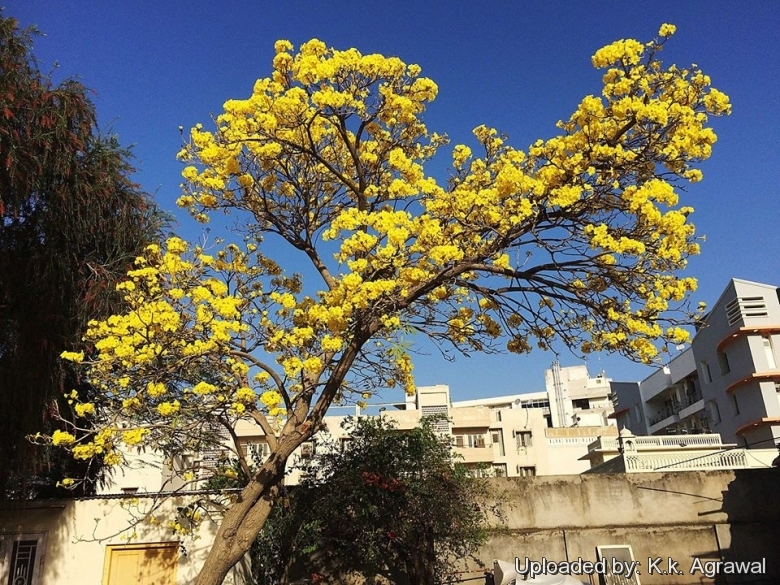
Bignonia aurea (Tabebuia aurea) Photo by: K.k. Agrawal
Origin and Habitat: South America (Venezuela, Suriname, Peru, Brazil: Roraima, Amazonas to Rio Grande do Norte, Mato Grosso to Paraíba to Paraná; Bolivia, Paraguay, North Argentina) , cultivated in tropical America and elsewhere in the tropics.
Habitat and ecology. This species grows naturally in riparian areas of the Caatinga of northeastern Brazil, where is a crucial resource for Spix's macaw (Cyanopsitta spixii), which is extinct in the wild with fewer than 100 birds remaining in captivity. Any future reintroduction would have to provide sufficient T. aurea for nesting and other purposes - while the tree is not considered threatened on a global scale, locally it has declined due to unsustainable use for timber.
Wild animals eat flowers and fruits.
Synonyms:
See all synonyms of Tabebuia aurea
back
Accepted name in llifle Database:Tabebuia aurea Benth. & Hook.f. ex S.MooreTrans. Linn. Soc. London, Bot. 4(3): 423. 1895 [1894-96 publ. Dec 1895]Synonymy: 18
back
Common Names include:
ENGLISH: , Tree-of-Gold, Silver Trumpet Tree, Yellow Tab, Yellow Poui, Caribbean trumpet-tree, Caribbean trumpet tree, Silver trumpet-tree, Paraguayan trumpet-tree, Golden trumpettree
ARABIC ( لعربية ): تابوبيا ذهبية
FRENCH (Français): tabébuia doré
PORTUGUESE (Português): pau-d'arco, para-tudo, paratudo, caraiba, caraibeira, carauba, caraúba, caroba-do-campo, cinco-folhas-do-campo, cinco-em-rama, craibeira, ipe, ipe-amarelo, ipê-amarelo, ipe-amarelo-do-cerrado, ipt-caraiba, ipê-caraiba, pao-d'arco
SPANISH (Español): tajibo morado (Bolivia), tajibillo (Bolivia), paratodo (Paraguay); paratudo (Venezuela), lapacho amarillo(Paraguay), alchornoque (Bolivia), alcornoque (Bolivia)
THAI (ภาษาไทย): เหลืองปรีดียาธร
VIETNAMESE (Tiếng Việt): Chuông vàng, Cây chuông vàng
Description: The Tree of Gold (Tabebuia aureaSN|32762]]SN|32748]]) is a most striking tree when in flowering. It is a small (5-10 m tall), dry season-deciduous tree with thick, narrow, lanceolate leaves. The plant bears dense, terminal clusters of bright yellow, funnel-shaped flowers in a leafless condition. The bloom cycle is relatively short, but the tree in full flowering looks most beautiful.
Remarks: This species is best known in literature and in cultivation as Silver Trumpet Tree (Tabebuia argenteaSN|32748]]SN|32762]]). The name 'argentea', meaning 'silver', refers to the silver cast of young foliage and branches. The silver cast helps distinguish this tree from the other yellow flowering species.
Stem: The tree is most easily identified by its puffy, fissured, cork-like bark. Its branches often grow with irregular curving patterns, giving the tree an interesting shape, and the trunk and canopy are frequently asymmetrical.
Leaves: Palmately compound, 5-7-foliolate; leaflets oblong, 6-15(-18) cm long, up to 4 cm broad, rounded to broadly obtuse at apex, rounded to narrowed at base, entire, densely silvery-lepidote ( with silvery scales) both above and below, the lateral nerves 6-9 pairs, the terminal petiolule up to 4 cm long, the lateral ones shorter.
Inflorescences: Loose terminal panicles or umbels, few-flowered.
Flowers: Bright yellow, showy; calyx campanulate to funnelform, yellowish, about 2 cm long. Corolla campanulate, 6-7 cm long, flaring mouth 6-6.5 cm broad, the 5 lobes semiorbicular, 2 cm long.
Blooming season In subtropical and tropical regions, this species displays it bright yellow blooms on leafless shoots at the end of the dry season. In Florida a few trees will begin flowering in late February, but the best performance comes in March or April. In summer, there is a second flower display on some trees. The second flowering does not match the intensity of the March bloom and there is no leaf loss.
Fruit: The fruit is a slender 10(-15) cm long capsule, oblong, narrow at each extreme, glossy, grey or grey-brown with black lines, somewhat woody.
Bibliography: Major references and further lectures
1) Gurcharan Singh Randhawa, Amitabha Mukhopadhyay “Floriculture in India” Allied Publishers, 1986
2) M.M. Grandtner, Julien Chevrette “Dictionary of Trees, Volume 2: South America: Nomenclature, Taxonomy and Ecology” Academic Press, 21 September 2013
3) Alain H. Liogier “Descriptive Flora of Puerto Rico and Adjacent Islands” La Editorial, UPR, 01 January 1995
4) Mark Stebbins “Flowering Trees of Florida” Pineapple Press Inc, 1999
5) Kepler, Angela Kay “Trees of Hawai'i”. Honolulu: University of Hawaii Press.1990
6) Huxley, A., ed. “New RHS Dictionary of Gardening.” Macmillan 1992
7) Bueno, M.L.; Damasceno-Junior, G.A.; Pott, A. "Structure of arboreal and herbaceous strata in a neotropical seasonally flooded monodominant savanna of Tabebuia aurea". Brazilian Journal of Biology 74 (2): 325–337. (May 2014).
8) Reis, FP; Senna Bonfa, IM; Cavalcante, RB; et al. "Tabebuia aurea decreases inflammatory, myotoxic and hemorrhagic activities induced by the venom of Bothrops neuwiedi". Journal of Ethnopharmacology 158 (Pt A): 352–7. (December 2014)
9) Brako, L. & J. L. Zarucchi. (eds.) “Catalogue of the Flowering Plants and Gymnosperms of Peru.” Monogr. Syst. Bot. Missouri Bot. Gard. 45: i–xl, 1–1286. 1993
10) Gentry, A.H. “Bignoniaceae–Part II (Tribe Tecomeae).” Fl. Neotrop. 25(2): 1–370. 1992
11) Wikipedia contributors. "Tabebuia aurea." Wikipedia, The Free Encyclopedia. Wikipedia, The Free Encyclopedia, 21 Dec. 2015. Web. 2 Apr. 2016.
12) Stephen H. Brown “Tabebuia aurea” retrieved 02 April 2016 from Institute of Food and Agricultural Sciences (IFAS) <http://lee.ifas.ufl.edu/Hort/GardenPubsAZ/TabebuiaAureaSilverTrumpetTree.pdf>
13) Forest & Kim Starr “Tabebuia aurea (Caribbean trumpet tree)”. Plants of Hawaii. <http://www.starrenvironmental.com>. Downloaded on 02 April 2016
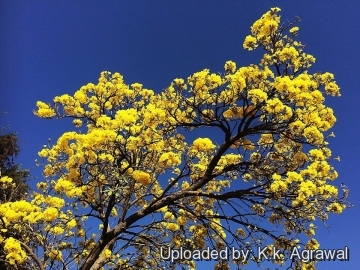 Bignonia aurea (Tabebuia aurea) Photo by: K.k. Agrawal
Bignonia aurea (Tabebuia aurea) Photo by: K.k. Agrawal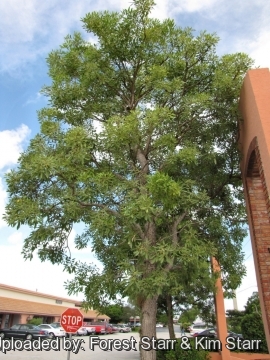 Habit at Starbucks Boynton Beach, Florida, Hawaii. September 23, 2009.jpg (Tabebuia aurea) Photo by: Forest Starr & Kim Starr
Habit at Starbucks Boynton Beach, Florida, Hawaii. September 23, 2009.jpg (Tabebuia aurea) Photo by: Forest Starr & Kim Starr Leaves at Enchanting Floral Gardens of Kula, Maui, Hawaii. March 01, 2012. (Tabebuia aurea) Photo by: Forest Starr & Kim Starr
Leaves at Enchanting Floral Gardens of Kula, Maui, Hawaii. March 01, 2012. (Tabebuia aurea) Photo by: Forest Starr & Kim Starr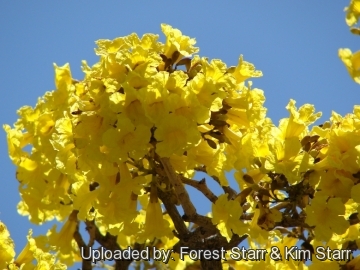 Bignonia aurea (Tabebuia aurea) Photo by: Forest Starr & Kim Starr
Bignonia aurea (Tabebuia aurea) Photo by: Forest Starr & Kim Starr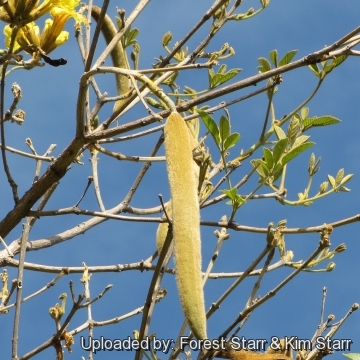 Seedpods at Enchanting Floral Gardens of Kula, Maui, Hawaii. March 01, 2012. (Tabebuia aurea) Photo by: Forest Starr & Kim Starr
Seedpods at Enchanting Floral Gardens of Kula, Maui, Hawaii. March 01, 2012. (Tabebuia aurea) Photo by: Forest Starr & Kim Starr Bignonia aurea (Tabebuia aurea) Photo by: Forest Starr & Kim Starr
Bignonia aurea (Tabebuia aurea) Photo by: Forest Starr & Kim Starr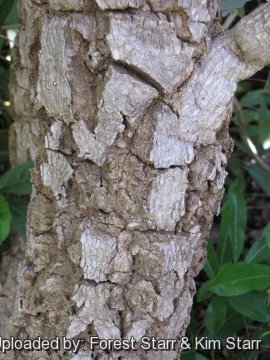 Bark at Resort Management Group Nursery Kihei, Maui, Hawaii. February 09, 2011.jpg (Tabebuia aurea) Photo by: Forest Starr & Kim Starr
Bark at Resort Management Group Nursery Kihei, Maui, Hawaii. February 09, 2011.jpg (Tabebuia aurea) Photo by: Forest Starr & Kim Starr Trunk at Makawao, Maui, Hawaii. April 16, 2009.jpg (Tabebuia aurea) Photo by: Forest Starr & Kim Starr
Trunk at Makawao, Maui, Hawaii. April 16, 2009.jpg (Tabebuia aurea) Photo by: Forest Starr & Kim StarrCultivation and Propagation: The Tree of Gold is one of the most spectacular of flowering trees, especially when grouped. Flowering is brief, intense and is usually started and completed by all trees in close unison. It is planted as an ornamental and persistent tree. It is good for planting along avenues and in parks and home gardens.
Growth Rate: Medium.
Soil: This species grows well in a wide variety of soils and requires little maintenance.
Transplanting: This species is known for being shallow rooted and topples easily if not staked at planting. However, older well-established trees commonly remain standing, even after hurricane force winds. Newly planted trees may shed all their leaves in response to transplant
shock.
Salt Tolerance: High
Drought Tolerance: High
Hardiness: Tropic and subtropics only. The tree at young stage is likely to be damaged by frost.
Uses: Park, Patio, Specimen, Street scape.
Traditional uses: This species is used against flu, hepatitis and inflammation. The leaves are are febrifuge and purgative. The roasted leaves are a mate substitute, stimulant.
Your Photos

by Forest Starr & Kim Starr


















